Mealworms were created on the 6th day of creation
24 Then God said, “Let the earth bring forth the living creature according to its kind: cattle and creeping thing and beast of the earth, each according to its kind”; and it was so.
Genesis 1:24
![]()
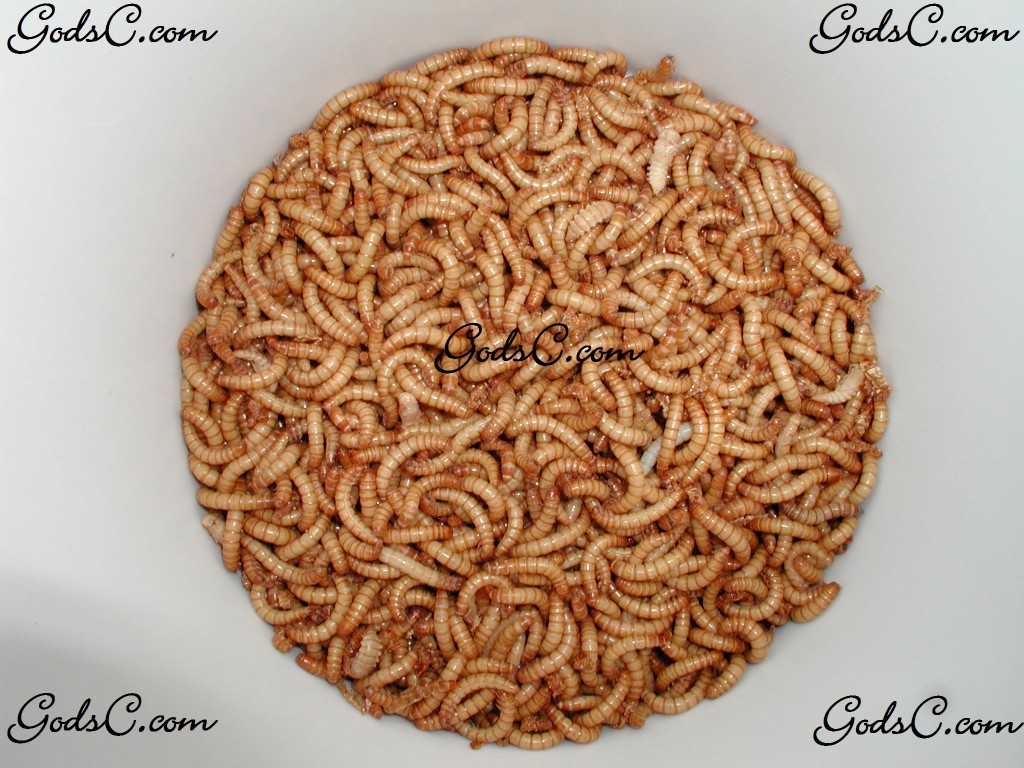
About the mealworm:
 The first thing you need to know is that mealworms are not worms. They are larva from an adult beetle. These beetles are a kind of Darkling Beetle. The reason why they are called mealworms is simply because they look like worms as larva. If you look closely at a mealworm you will see it has six legs. When a male and female beetle mate the female will lay 100’s of eggs that are whitish in color (and about the size of a pin head) that will hatch in about 2 weeks. As the larva grows it will shed its exoskeleton; a little like a snake would do. When the larva becomes around an inch in length, (if it is a small mealworm) it will cocoon into a pupa. Their are many kinds of Darkling Beetle species. When hatching a white colored beetle will emerge, and will soon darken to brown, then black. The beetles will live for 2-5 weeks. After this last stage, it starts all over again. There are three sizes of mealworms that pet stores sell; the small mealworm (grows to about an inch and then turns into a pupa), the giant mealworm (grows to about two inches and then turns into a pupa), and the supper mealworm (grows to about three inches and then turns into a pupa). Mealworms can be a great source of food to feed a number of different kinds of animals like: amphibians, reptiles, birds, and rodents. It is important to note that it is never a good idea to feed only mealworms to amphibians or reptiles because mealworms are sometime not high enough in protean to meet an amphibian or reptile’s needs. Mealworms are also harder to digest because they have an exoskeleton. I am not saying mealworms are bad to feed, I am just saying they should not be fed as a sole diet. Mealworms are a lot easier to care for compared to crickets and they do not escape or stink like crickets!
The first thing you need to know is that mealworms are not worms. They are larva from an adult beetle. These beetles are a kind of Darkling Beetle. The reason why they are called mealworms is simply because they look like worms as larva. If you look closely at a mealworm you will see it has six legs. When a male and female beetle mate the female will lay 100’s of eggs that are whitish in color (and about the size of a pin head) that will hatch in about 2 weeks. As the larva grows it will shed its exoskeleton; a little like a snake would do. When the larva becomes around an inch in length, (if it is a small mealworm) it will cocoon into a pupa. Their are many kinds of Darkling Beetle species. When hatching a white colored beetle will emerge, and will soon darken to brown, then black. The beetles will live for 2-5 weeks. After this last stage, it starts all over again. There are three sizes of mealworms that pet stores sell; the small mealworm (grows to about an inch and then turns into a pupa), the giant mealworm (grows to about two inches and then turns into a pupa), and the supper mealworm (grows to about three inches and then turns into a pupa). Mealworms can be a great source of food to feed a number of different kinds of animals like: amphibians, reptiles, birds, and rodents. It is important to note that it is never a good idea to feed only mealworms to amphibians or reptiles because mealworms are sometime not high enough in protean to meet an amphibian or reptile’s needs. Mealworms are also harder to digest because they have an exoskeleton. I am not saying mealworms are bad to feed, I am just saying they should not be fed as a sole diet. Mealworms are a lot easier to care for compared to crickets and they do not escape or stink like crickets!
Life Cycle:
1. The Egg
The egg will hatch in about 2 weeks
2. The Mealworm
Because a mealworm has an exoskeleton, it will shed every time it grows. Each time a mealworm sheds it will be soft and white until the new exoskeleton hardens, in about an hour, then it will become a darker color. A mealworm will shed its exoskeleton 9-20 times before it becomes a pupa. Fat round mealworms are a sign of a healthy colony and if you have a lot of mealworms that are flat on their bellies they need more food or the food you are feeding is not nutritious enough.
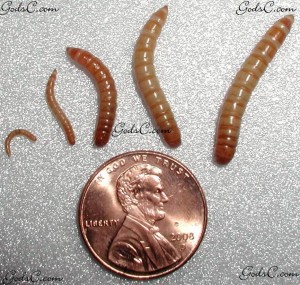
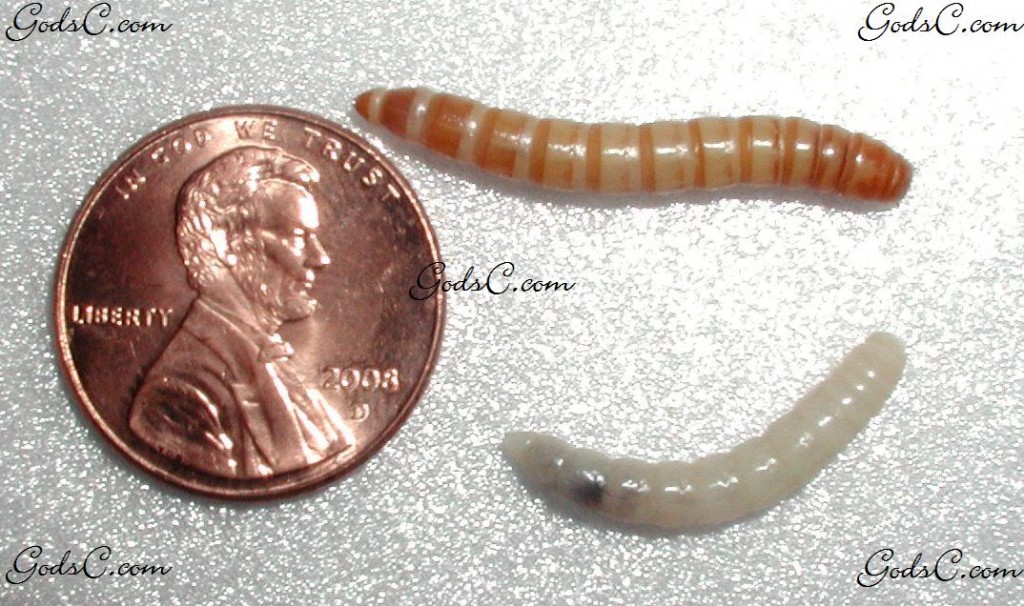
3. The Pupa
When a worm transforms into a pupa it again becomes soft and white. Shortly after the pupa will darken and harden just like the mealworm would do when it sheds.
4. The Adult Beetle
This is the final stage. After about 2 weeks the transformed worm will emerge as a creamy whitish beetle. The beetle will darken to a brown color and then black. Sometimes if a worm was not healthy when it started to cocoon, when it hatches it will stay brown and or even have a deformed body. If you feed your worms well before they go in to the pupa stage they will come out and turn a nice black color. Also, if a worm or beetle is white and soft they will sometimes be eaten on by other worms or beetles. If this is happening alot, it is because they are not getting enough nutrition and need more food, or you have too many sizes and stages grouped together and you need to separate them. Nice dark beetles are a sign of a healthy colony.
Housing:
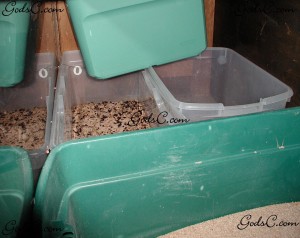 Plastic is the best to work with because it is not going to break if dropped like glass and it is a lot lighter too. You can buy plastic storage tubs at places like Wal-Mart or Target and these tubs make great housing for mealworms. I think the cheapest place to buy them is at Wal-Mart. Sometimes other stores will have clearances (IE Target) or sometime stores will discount plastic storages boxes that are missing lids and this is perfect because you do not need the lids. Mealworms do not climb, jump, or fly like crickets and cockroaches and the beetles are not going to fly out of a tub with food and plenty of beetles to mate with in it. I don’t think my mealworm beetles can fly one foot high. When I breed mealworms, I never use lids because I have never had a problem with flying beetles! Usually beetles only use their wings to turn themselves over if they get stuck upside down on a hard surface. It is easy when selecting a tub for you worms/beetles because you don’t have to find a very tall tub and you don’t have to worry about finding the smoothest tub to prevent climbing.
Plastic is the best to work with because it is not going to break if dropped like glass and it is a lot lighter too. You can buy plastic storage tubs at places like Wal-Mart or Target and these tubs make great housing for mealworms. I think the cheapest place to buy them is at Wal-Mart. Sometimes other stores will have clearances (IE Target) or sometime stores will discount plastic storages boxes that are missing lids and this is perfect because you do not need the lids. Mealworms do not climb, jump, or fly like crickets and cockroaches and the beetles are not going to fly out of a tub with food and plenty of beetles to mate with in it. I don’t think my mealworm beetles can fly one foot high. When I breed mealworms, I never use lids because I have never had a problem with flying beetles! Usually beetles only use their wings to turn themselves over if they get stuck upside down on a hard surface. It is easy when selecting a tub for you worms/beetles because you don’t have to find a very tall tub and you don’t have to worry about finding the smoothest tub to prevent climbing.
Bedding:
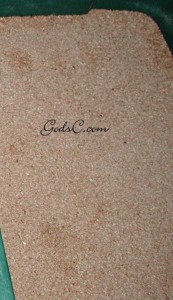 I use wheat bran for my bedding because it is a source of food and it keeps the worms off each other so they do not over heat. I place 2-5 inches of bran in a tub depending on how many will be living in the bedding. Depending on the size of your plastic tub and how many mealworms you are going to put in it will determine how much bedding to put in. If you have a large colony, put more bedding in so they have enough room to not be on each other. You can also use raw oatmeal but wheat bran is cheaper and you can buy it at most feed stores for around $12.00 for 50lb. If you only want to breed a few mealworms you can use the oatmeal; but if you want to breed them in bulk go with the wheat bran.
I use wheat bran for my bedding because it is a source of food and it keeps the worms off each other so they do not over heat. I place 2-5 inches of bran in a tub depending on how many will be living in the bedding. Depending on the size of your plastic tub and how many mealworms you are going to put in it will determine how much bedding to put in. If you have a large colony, put more bedding in so they have enough room to not be on each other. You can also use raw oatmeal but wheat bran is cheaper and you can buy it at most feed stores for around $12.00 for 50lb. If you only want to breed a few mealworms you can use the oatmeal; but if you want to breed them in bulk go with the wheat bran.
Preparing the wheat bran:
An important note about wheat bran is sometimes there are tiny black beetles, or bugs that are so tiny they are almost invisible, like tiny grain mites. If your mealworms have contact with grain mites you may very well lose the entire colony! I have experienced this first hand and let me tell you it was terrible. To prevent this from happening all bedding should be heated up in the oven. I use 4 large glass trays and fill them to the top with bran and place them in the oven. You do not want to burn the bran or bake it, you just want to kill any living things that might be in it. Heat it up to 175-200 degrees Fahrenheit for about 20 minutes. Take care to watch it closely to make sure it does not burn. Last thing about the bedding: make sure it has cooled plenty before adding mealworms or beetles to it, as hot temperatures over 95 degrees Fahrenheit can kill them.
My experience with grain mites:
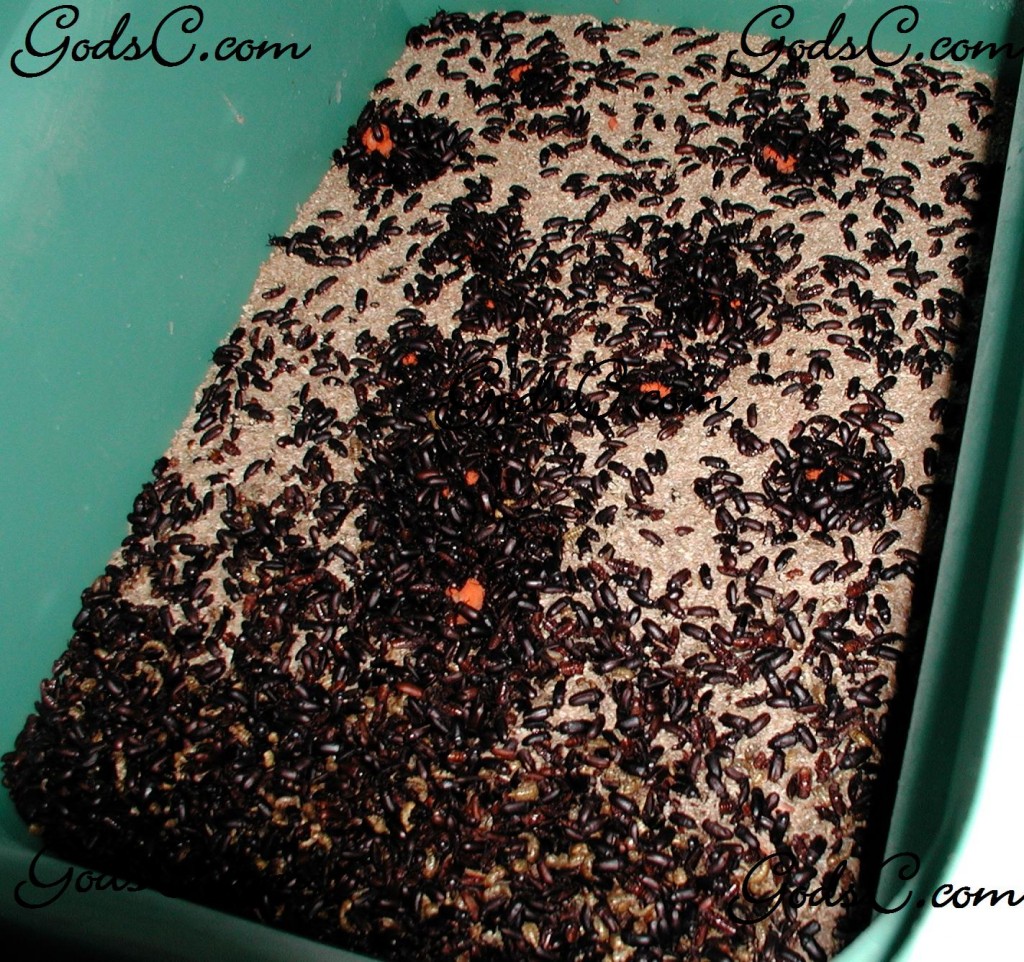 It started out with these little white colored bugs that would gather on the mealworms’ food that was moist like carrots. Then next thing I knew these little bugs had attached themselves to my beetles! These little bugs multiplied rapidly and soon every beetle and worm had them. When these bugs attached themselves to my beetles and worms they constricted the movement of beetles and worms thus stopping them from being able to get to the carrots for water/food. In the end these tiny bugs killed off my entire colony.
It started out with these little white colored bugs that would gather on the mealworms’ food that was moist like carrots. Then next thing I knew these little bugs had attached themselves to my beetles! These little bugs multiplied rapidly and soon every beetle and worm had them. When these bugs attached themselves to my beetles and worms they constricted the movement of beetles and worms thus stopping them from being able to get to the carrots for water/food. In the end these tiny bugs killed off my entire colony.
More about grain mites:
Grain mites are very small, whitish/yellow in color and stink. Often they are in wheat bran and when they come in contact with mealworms or the beetles they will attach themselves to them and lay eggs on them. Eventually there will be so many eggs and mites on the mealworms or beetles that they will no longer be able to move. Also, I think the mites may suck on the mealworms or beetles to slowly weaken them. I do not know of a way to kill the mites without killing the worms and beetles this is why it is so important to heat the wheat bran so that it kills any eggs and mites that may be present in the bran. Freezing the bran will not work on killing the mites or tiny bugs because they can go into hibernation for long, long periods of time. But cooking them is a different story. It is just like people cooking food; it kills off all the bacteria and tiny bugs. Would you consider raw frozen meat safe to eat? No, everyone knows you need to cook it. Also, sometimes home grown vegetables and fruits can carry harmful bugs. I use store bought carrots and have had no problems. I am sure they use chemicals of some kind on them that kill small bugs; however I have never had store bought carrots harm my mealworms but I do rinse them off first. Grain mites are very strong, durable bugs. The eggs can stay dormant for months and go without food. When they hatch from their egg they only live for about 17 days; but one female can lay hundreds of eggs a day! Grain mites thrive in high humidity levels especially over 75%, this is a good reason to not use lids on your tubs and not over feed your worms. If your colony should get grain mites the best thing to do is destroy them and start all over. If you want you can try lowering the humidity to under 55% and the grain mites should die but the trouble is the eggs that the grain mites lay are very durable, and could survive.
Feeding:
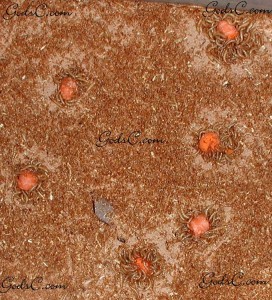 An interesting fact about mealworms is they are mostly nocturnal, so night is the best time to feed them. I feed my worms once every night. I feed them carrots that have been rinsed off with water. I cut them up into small slices or cubes. Use caution not to feed more than they can eat in 24 hours or so. If you feed too muc the carrots will become molded causing bacteria killing the worms. If you do feed too much on accident just don’t feed them for 48 hours. Check under the wheat bran to see if they still have carrots left before feeding. Also you can feed them other things like potatoes or apples but then you have to remove the skins that the worms and beetles do not eat. I buy 25lb of carrots in the produce section for $5.99 at Albertsons.
An interesting fact about mealworms is they are mostly nocturnal, so night is the best time to feed them. I feed my worms once every night. I feed them carrots that have been rinsed off with water. I cut them up into small slices or cubes. Use caution not to feed more than they can eat in 24 hours or so. If you feed too muc the carrots will become molded causing bacteria killing the worms. If you do feed too much on accident just don’t feed them for 48 hours. Check under the wheat bran to see if they still have carrots left before feeding. Also you can feed them other things like potatoes or apples but then you have to remove the skins that the worms and beetles do not eat. I buy 25lb of carrots in the produce section for $5.99 at Albertsons.
Watering:
As for water you do not need to give them any. They get all the water they need in the carrots.
Location to breed you worms:
I breed my mealworms inside my house in a room that does not get too cold in the winter nor too hot in the summer. I do not keep them near any windows, to not to take any chances of mites or other bugs finding their way to the mealworms. A good temperature to breed mealworms is about 77 degrees Fahrenheit; but it is not a huge deal if it gets a little cooler or hotter. I breed them in my house at what ever the temperature happens to be at. I would not breed them in a shed or garage because it will be too hot in the summer and most likely kill a good number of them and in the winter it will be too cold. All this will slow down their breeding rate and growth. Also, if you have cats make sure they don’t use the tubs as litter boxes! Last thing; if you have a person that sprays your house with bug poison, make sure it does not get sprayed on or in the tubs! It actually is a good thing to have bug poison sprayed in the same room as your mealworms because it will kill all the bad bugs that may get to your mealworms. Just make sure it is not sprayed heavily in the room. You should never place a tub inside another tub or else the poison on the bottom of the tub will get into the tub it is stacked in.
Sifting:
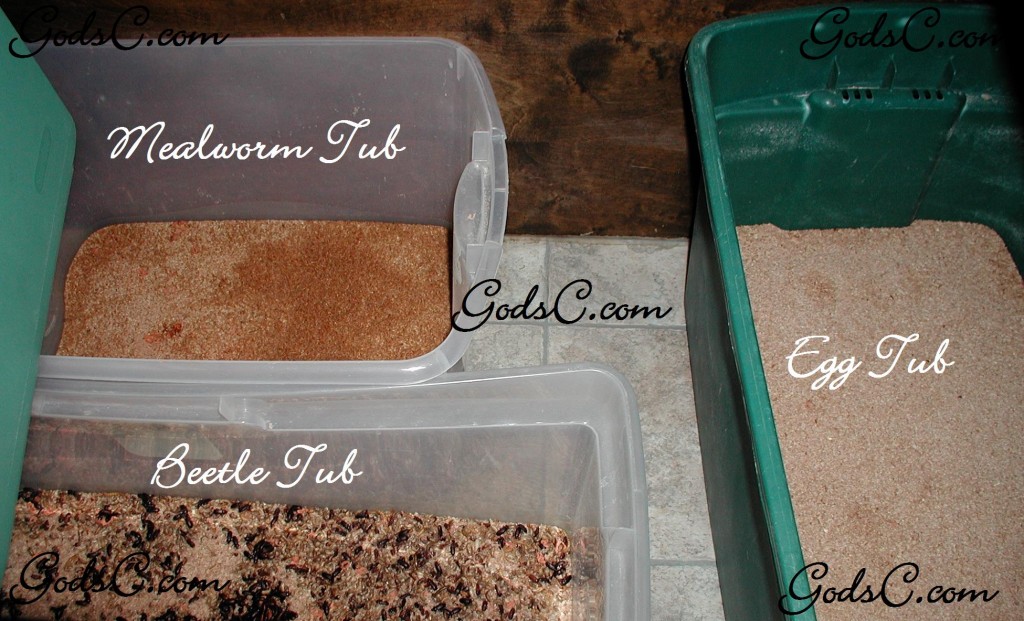 I find that it is best to separate the different sized mealworms and beetles so competition for food is even and the bigger ones don’t eat the smaller ones. To do this I take a tub right before the large worms cocoon and throw out the old bedding. All of the old bedding is now exoskeleton casings from the worms and they will need fresh clean bedding to lay their eggs in for the new worms to grow up in. When the beetles have been hatched for about 3 weeks they will have layed lots of eggs, I then sift them out from the bran again. The bedding that is now separated from the beetles contains thousands and thousands of eggs so don’t toss it out and remember to feed them even if you can’t see the tiny worms yet! I place the beetles in fresh bedding and repeat the process again in about 3 weeks. If you do this and keep the beetles old bedding by itself the eggs will hatch and grow up together meaning they will all be around the same size. This makes them easer to sift small amounts out for selling or feeding. If you are selling, most people want the large mealworms. If you do not do this sifting method you would have all sizes of worms and beetles mixed together, and if you have someone wanting to buy 1000 large worms you would have to pick them out by hand! You can buy colanders at a dollar store or make you own sifters up out of wire screen. Depending on the size of mealworm you are breeding will determine how big the little holes of slits should be. You want all the bran to fall through but you want the worms or beetles to stay in so don’t use big holes.
I find that it is best to separate the different sized mealworms and beetles so competition for food is even and the bigger ones don’t eat the smaller ones. To do this I take a tub right before the large worms cocoon and throw out the old bedding. All of the old bedding is now exoskeleton casings from the worms and they will need fresh clean bedding to lay their eggs in for the new worms to grow up in. When the beetles have been hatched for about 3 weeks they will have layed lots of eggs, I then sift them out from the bran again. The bedding that is now separated from the beetles contains thousands and thousands of eggs so don’t toss it out and remember to feed them even if you can’t see the tiny worms yet! I place the beetles in fresh bedding and repeat the process again in about 3 weeks. If you do this and keep the beetles old bedding by itself the eggs will hatch and grow up together meaning they will all be around the same size. This makes them easer to sift small amounts out for selling or feeding. If you are selling, most people want the large mealworms. If you do not do this sifting method you would have all sizes of worms and beetles mixed together, and if you have someone wanting to buy 1000 large worms you would have to pick them out by hand! You can buy colanders at a dollar store or make you own sifters up out of wire screen. Depending on the size of mealworm you are breeding will determine how big the little holes of slits should be. You want all the bran to fall through but you want the worms or beetles to stay in so don’t use big holes.
Cleaning:
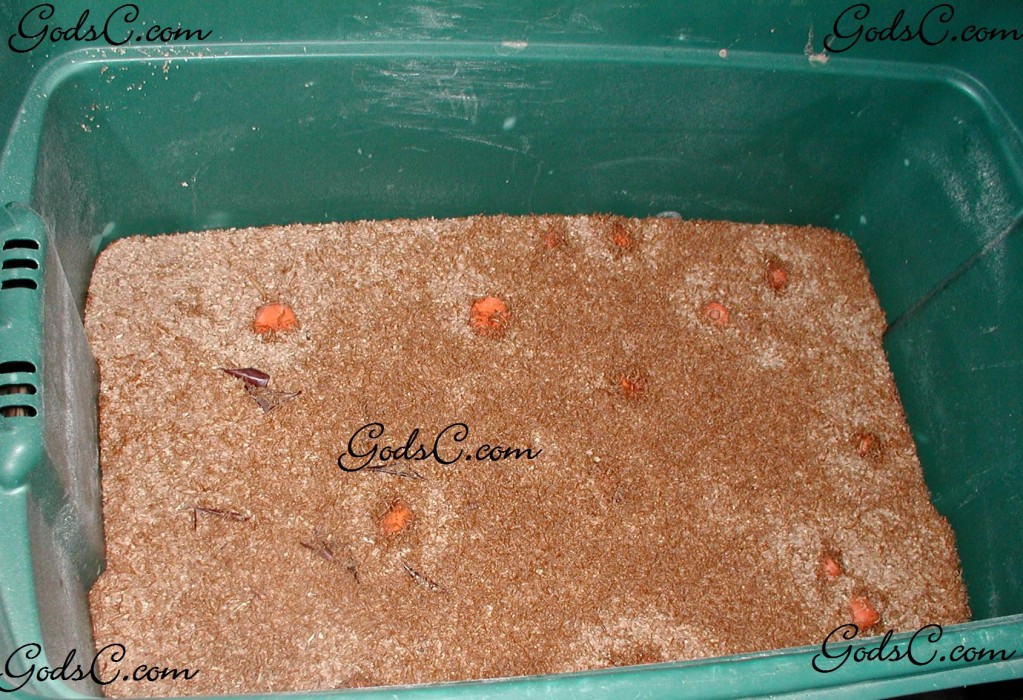
When the worms have grown some they will have a lot of shed resting on top of the bran. It is a good idea to get all that extra shed out of your worm tubs. Do this outside and you may want to wear a mask to keep stuff out of you nose and mouth. Take a hair dryer (use it on the coolest setting) and blow all the shed off the top of the wheat bran. You can also do this to the beetles, but after you sift them out, and then put them in a container before placing them in new bedding. When blowing the beetles you want all the dead ones to blow out as well. Because the dead ones are dried up inside they are lighter, but be carful not to blow too hard or you will blow the living ones out also!
Counting your worms for selling:
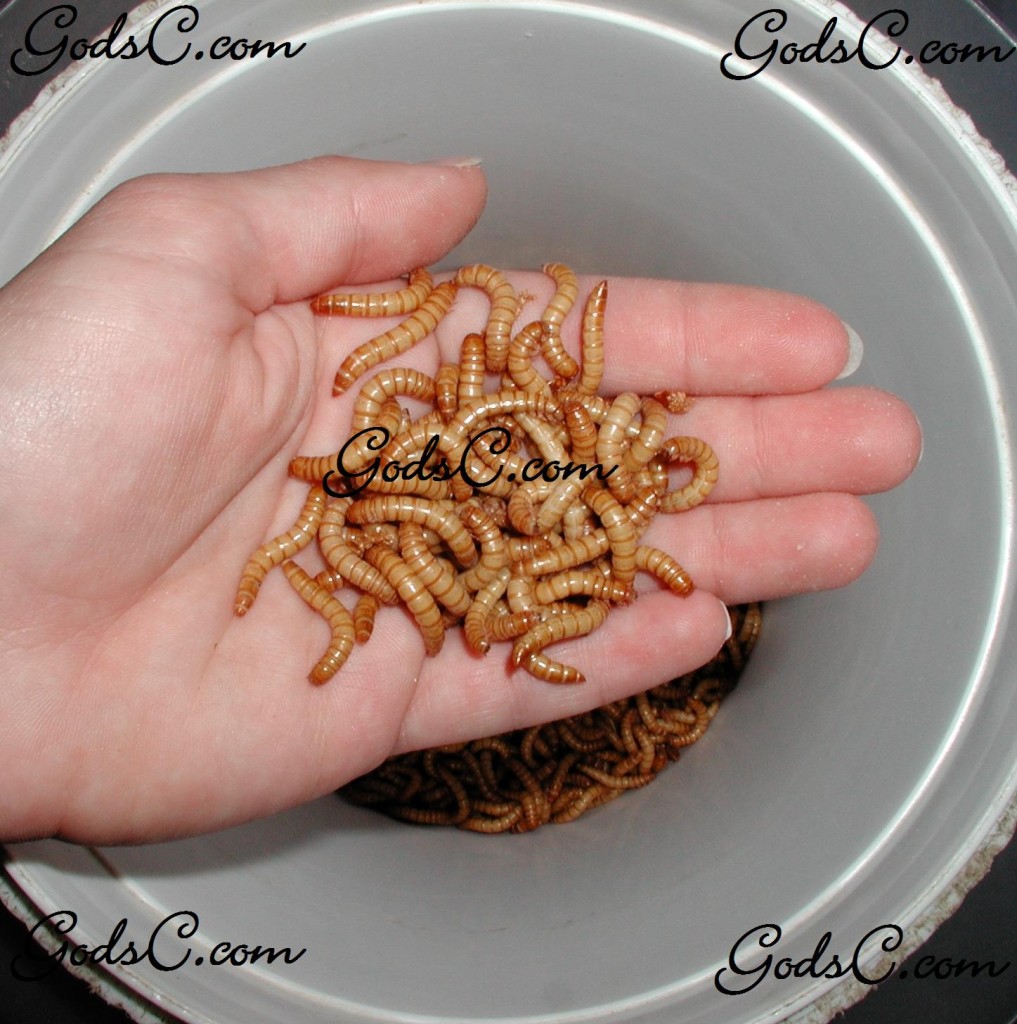
I would often sell my extra mealworms to people in increments of 1000. So, how did I measure out 1000, did I count them all out every time I had a buyer? No! I counted out 100 mealworms and weighed them on a letter scale and then multiplied that times 10 and came up with how much 1000 large mealworms weighed. If you do not have a letter scale you can use a large cup and count out 1000 mealworms and mark it with a line. You can also measure out other numbers of mealworms on the same cup by labeling the amount above the line. Sometimes you may have buyers that only want 500 or 100 mealworms. It is best to have a way to measure out all kinds of amounts.
Buying mealworms to start up your colony:
I recommend that you do not buy mealworms form Pet Smart or PetCo just because they normally cost more at these stores. You can buy mealworms at most feed stores. Just call around and see who has the best price. Most stores sell mealworms in increments of 100-200 but what if you want to start your own colony? You will need at least 500 worms to get off to a good start. So where do you find mealworms in bulk? Some feed/pet stores are able to make a special order for you but if you want you can also order them online. I have used New York Worms, and they are easy to order from because their prices include shipping. You just need to do a little research to find the cheapest price and if you order online make sure they are 100% guaranteed to arrive alive. Also if you can find mealworms that are young you will have better success. I have ordered older mealworms that were ready to cocoon and they did very soon after I got them. Now why is this a problem? Often mealworms are kept in the refrigerator and this causes them to stop at the size or stage they are in and their bodies feed off their fat reserves. If you suddenly take older worms out of the refrigerator they instantly go into the transformation from worm to pupa. This is bad because all that fat and nutrients is almost all used up and they will not have enough nutrients to get them through the transformation from worm/larva to the adult beetle. You will have a lot of deformed and malnourished beetles hatch and a good portion of them will die. Even if the place you order from does not refrigerate their worms, it is still best to buy younger worms so you have time to feed them and bring them up healthy. Often large companies can not produce as healthy mealworms as an individual because they simply have a lot of worms. The individual is able to give more care and time to a small amount of worms. I hope that all my info has helped you and if you have any questions just fill out the box below.

Hello and thank you so much for the reply. We have hand-picked the maggots & cocoons out, and numbers seem to be diminishing. We’re keeping the fresh food fresh – unfortunately the pantry moths love the bedding. We also tried the trick of looking under a big piece of food and have found baby mealworms – hurrah! They look completely different to the maggots and exactly like the teeny mealworms in your photos with the penny! Thanks again! Pip
and exactly like the teeny mealworms in your photos with the penny! Thanks again! Pip
Hello Pip,
That is a rough situation! Is it possible you have too much humidity in your cage? Have you tried changing out the carrots every day and replacing them with fresh to help avoid attracting these unwanted pest? Flies or other flying pest can get into your tubs with the smallest gap or your fine mesh. have you tried cutting out the tub lids and putting the mesh over the tup and pressing the lid on top of the tubs to create a tighter seal? We don’t have any great advice to get these unwanted pest out of your colony other then to start hand picking them out, especially get those cocoons out before they hatch and breed more.
Hey Amanda,
the larva will come to the to and become pupas. You can remove them at this stage if you wash and place them in new bedding to lay their eggs when they hatch. Pupas can overheat if they get too crowded on top of each other. Also be sure you have enough food to feed all the larvas and adults too if you have them together otherwise they will become cannibals and eat the pupas.
Hi im just wondering if i need to sift through my worms to find the pupae or will they come to the top of the oats to turn into pupae? Thank u
Hello,
I’m in Australia and growing a small mealworm colony for the first time. We have fly-wire mesh over the tub so that pests can’t get in. We have had beetles for several weeks now, and have just noticed white maggots crawling up the sides of the tub and cocooning around the edges. I’m assuming a pest has gone in, and we are looking at pantry moth maggots or something similar? They have no interest whatsoever in the carrots, and the beetles have no interest in eating the maggots! Does anyone have any ideas on how to get rid of the maggots without damaging the colony?
Thanks!
Hello Lynn Cardwell,
We use to do this as well but it did not work for us. You have to remember that the eggs of mites are very resilient! Freezing them often just makes them remain dormant and they go into a hibernation. The eggs will hatch when they warm up after the freezer and even the larva and adults can survive a hibernation in the freezer. Freezing may kill off some but not all of them and 48 hours might not be long enough to kill any. The only success we have had is cooking the bran to ensure all of the mites die.
I live in UK and breed mealies. All the wheat and oat bran is put in the freezer for about 48 hours before being added to the bedding. This is easier than going to the bother of cooking. Never add to bedding direct from the freezer. Even our ‘human’ flour for baking contains microscopic mites so that’s always stored in polythene bags in the freezer permanently.
Hi brad klaas,
We do NOT recommend giving leftover people food to mealworms. We only recommend fruits and veggies be given to mealworms. We are sorry to hear about your sad experience with your worms. It could have been the high salt, preservatives, or something else that caused them to die from that food.
Hi Raymond Downs,
It sounds like you are doing everything right. Did you get your colony started from the larva stage or did you purchase them as beetles/adults? The beetles that you have are Darkling Beetle correct, and not some other kind of beetles? 77 degrees Fahrenheit is about the right temperature to breed them at. Be sure you have fresh carrots available at all times so when you do have eggs and they hatch, they will have water to drink. If you are letting the carrots dry out, any eggs that do hatch, will not grow into nice healthy larva and you may never see them if they die before getting bigger.
I have 100 black bugs for 3 mo have not had any eggs or baby worms bugs r breading no worms or eggs temp good tubs clean plenty bran and carrots
i gave some left over oriental food to mealworms and the next day all of them were dead!! what in the food could have caused this and is it ok to still feed them to things so as not too waste them? i feel so bad that this happened.
if possible could you send reply to my email? thank you
Thank you! I’ll see if I can get a picture. Have a blessed day!
Hi Amy Reagan,
If these are grain mites and they did NOT come from your bedding, food, or from other mealworms you brought in, they could be coming from outside your house. Little bugs can get inside from window seals. If these are not little mites on your mealworms it could be dust, in witch case it should come off when you touch them with your finger. If it’s not mites or dust it could also be some kind of fungus growing on your worms. If you can get a good clear photo of your mealworms you are welcome to email it to us.
Hi! Thank you for your website! Very helpful! My dad & me are raising mealworms and waxworms. At the present we don’t have any adult waxworms or moths, but we have noticed a bunch of little bitty bugs on are mealworms and do not know if they might be babies of the waxworms or if they are mites. There are smaller than saw dust. I call them them my saw dust babies! LOL! We do not think they came from are wheat bran, because we started new colonies in another room and have not seen the saw dust babies. We just started doing this a few months ago and are still learning. Any info you have would be greatly appreciated! Thank you and God Bless You!
Hi Mark,
Sorry to hear about the grain mites. If the grain mites did NOT come from your bedding, food, on the cricket, or from other mealworms you brought in, they could be coming from outside your house. Maybe if you sprayed bug poison around your windows and doors and maybe around the floor along all the walls to create a barrier. Just make sure you remover your colony before you spray any poison and let it dry and air out before bringing your bugs back into the room. Grain mites are tough little guys to get rid of.
I wonder if ladybugs could be of use to destroy the grain mites? You can order them on line and have them shipped to your house. Gardening websites should have them for sale. The ladybugs may eat some of your tiny larva but if they will eat the grain mites it would be worth it.
I started breeding mealworms and superworms a few months ago. Have a well established colony of worms and adults. Had a breakout grain mites in cricket colony. I learned to control that by spot cleaning the dead crickets and replacing all food and water containers weekly. Also added a 12hr heat lamp over the cage. The mites didnt go away but theyre under control. Today I found mites on the mealworms and superworms colony. Theyre attracted to the moisture of the carrots. If you move a carrot there are so many they fall off in clumps. I realize that I could start over. But I have no reason to believe I will not get mites again. Were in South Florida and there are lots of critters here. I feel that the grains I used were likely NOT the source of the infestation. So starting over with steril grain will not solve anything for me. HAVE ANY SUGGESTIONS?????
Hello Brian,
You may have larvae and they are just too small for you to notice. Also your temperature could be too cold. Another thing to consider is are you offering enough fresh carrots so they can get a drink. If the larvae can’t get moisture they can’t grow or may die.
my beetles are nearly 60 days old and still no larvae…? What am I doing wrong??
Thank you!
Hi Joanna,
That is a good question to ask :). For smaller batches we took a microwavable bowl and filled it. We then took a microwavable glass and filled it with water and placed the glass into the center of the bran. We cooked it in the microwave until it was good and hot and we would stir it from time to time to make sure the center got hot. We also baked lager amounts of bran in the oven but you may consider covering it so the top won’t burn. Just make sure to let it set when your done and let it cool slowly. Don’t put any beetles or larva into the ban until it has cooled to room temperature. You might also be able to put bran in a black trash bag and hang it in the sun for a few days if is’t hot enough outside.
Hi, you didn’t mention the actual procedure for cooking the oat bran. Could you please enlighten me lol. Sorry if this is a stupid question:) thanks so much, super helpful info
Hi Mistie,
We are not sure what kind of bugs you have living with your mealworms. A lot of different bugs can get into bran. We’ve only experienced grain mites and weevil type bugs. You should look up weevils to see photos and compare them to what you have. This is why it is so important to always bake your wheat bran to kill off any unwanted bugs before putting your mealworms in it. Once you get bugs in your brand it’s hard to kill them off without killing your mealworms too. Sometimes the only thing you can do is start over. Also even if you baked your wheat bran sometimes bugs can later find their way into your mealworm bin. If you have a pest company that sprays your home, and you keep you mealworms in the house, it is less likely unwanted bugs will get into you mealworm tub. Also keep your mealworms away from windows as unwanted bugs can get into the house from closed windows.
Hi, I just started raising mealworms and I have my first tub of baby mealworms growing. My problem is I have started noticing little black jumping bugs in my bran. Not alot of them but a few here and there and was just wondering if you knew what they might be. They almost look like fleas but not sure. Have you experienced this before or do you know what they could be? Any advice would be great, thank you and God bless. Mistie
There are several possibilities. Here are some questions to ask yourself: are your bins clean enough, is the temperature too cold, are your bins overcrowd and the chrysalis become smothered, have your larva been kept in the refrigerator causing them to use up most of their nutrients in hibernation thus they don’t transform properly in the chrysalis stage?
Very nice web I get a lot of bettles deformed I feed daily carrots celery potatoes wondering why thank you
Hi Lauren,
These are mealworms and they come from a type of Darkling Beetle.
What are they called
Hi again Eunice,
It’s not very easy to tell the difference between male and female. If you wanted to get rid of the shedding with the hair dryer, you would need to hold it a few feet away from the cage as it will blow the little babies away. As for your question about how often to change the bedding, it just depends on how many worms you have and how much bedding you have them in. You could change the bedding for every new cycle of worms or as it gets dirty and eaten.
Thanks for the answer. It seems that another beetle have died and I only left 3 beetles. Anyway, do you know how to differentiate a female beetle and a male beetle. Please tell me if u know. It would be helpful. I saw a lot of baby mealworms today and I’m quite happy with it. They have grown a little but some are still small. I saw some sheded skin too. At 1 part of the text, u said we could blow of he skin with a hair dryer. But I’m scared I could also blow the mini mealworms away. Will it? By the way, it has not been 3 weeks since I changed a new bedding. I still use oatmeal. I still have a quarter of a packet of oatmeal left. I’ll use finish them. Last question, how long do we have to change the bedding?
He Eunice,
After the mealworms are in their adult stage (the Beetle) they only live for a few weeks. We like to use wheat bran as bedding but you could use oatmeal for 50 worms. Smaller worms do not come to the top of the bedding that often but the large worms and beetles do. Instead of sifting you can just take out all the big worms and beetles every 2-4 weeks and place them in a new cage with new bedding. This will allow the eggs to hatch and the other smaller worms to grow up by themselves. When the smaller worms are grownup take them out and give them a new cage with new bedding and clean the old cage out for other worms.
I didn’t want to start a colony but I had 20 mealworms at first. Then, for some reasons, they died. And I left 10. But soon, the died as well and I left only 4. I don’t understand why they died. I do feed them. But luckily for me, I found some baby mealworms. But it seems to be hiding a lot. It never comes to the top of the bedding. I use oat meal for my bedding. It’s okay, right? But I think I’ll have to change to wheat bran sooner or later. But may I ask if I have 50 mealworm, can I still use oatmeal? I hope I can… And also, I’m not so sure how to sift and which sifter is suitable to use.
Hello Carol,
Not sure what you are doing wrong if anything. The beetles lay their eggs in the bedding and sometime on the cage floor (the eggs often stick to the cage floor). You will need to supply the newly hatched eggs with a water source like you are doing even if you don’t see the babies yet. It dose take a few weeks for the eggs to hatch and the newly hatched larva to grow bigger. Maybe you just don’t see them yet as they are so small when they first hatch. If you don’t see larva within 4 weeks after the eggs are laid then you have a problem. You should be able to see tiny larva on the underside of the veggies/fruit.
Hi,
I am trying to breed mealworms as I have 48 chickens and would like a treat source for them a couple of times a week. I have about 500 worms and they go through the cycle and become beetles but as yet no eggs. I separate the larvae, then separate the beetles into their own container, then every 2 weeks take the beetles out and put them into a new container, as I do this I tip all beetle bedding into this original container to get any eggs but still no baby worms. I use bran as bedding, lettuce, carrot and apple for water source. I check and separate daily. What am I doing wrong?? Thanks in advance.
Hello Lenore,
Wheat Bran looks like little flakes and if it is clumpy it could be because it got wet. We always would heat our Wheat Bran just incase there were any tiny bugs present. If you plan to sell your worms you can buy little sets of containers at a dollar store. Glad you are enjoying our site and we hope that you enjoy breeding mealworms as we have
I started breeding mealworms for my wild birds that come to the feeders. So far they haven’t taken an interest. I bought 50 lbs of wheat bran at the Co-Op and put it in some bins in the garage. It looks funky so I’m afraid to use it. Do you think if I do the oven thing that it would be okay to use. It’s kind of lumpy. Also, when you sold the mealworm did you just give them the worms and the buyer was responsible for the bedding and such? What did you put them in? If my birds aren’t going to eat the worms then I need to be able to get rid of them before they take over the bins! Thanks for the info. It has been very helpful.
Ok, thank you 😀
Hello Alex
Refrigerating mealworms will slow down how quickly they reproduce. When a mealworm is placed in the refrigerator it goes into hibernation and feeds off its fats. When the mealworm is taken out of the refrigerator it will turn into a pupa if it is an older larva. This is always a bad thing when a larva tries to true into its pupa after hibernation. All of its fats that it used to live on during hibernation are now mostly used up and the larva will not have enough energy to transform to the beetle. The larva will die in its pupa stage. The refrigerator should only be used if you want to stop a larva from turning into its adult stage, the beetle. Remember that the more beetles you have to lay eggs the faster your colony will grow.
Hi, it’s Alex, I was just wondering is it necessary to refridgerate mealworms in order to save up enough to sell or does a colony over time get large enough for that not to be a problem?
Hi Caleb,
A good amount to start off with is around 500. I started my colony off with 1,000.
How many worms do you start out with?
Hi Caleb, That is funny about your mouse and snake, just make sure the mouse does not start to nibble on the snake.
That is funny about your mouse and snake, just make sure the mouse does not start to nibble on the snake.
If you mom changes her mind about the mealworms I have some to get you started with
hi its caleb thank you for giving me your website ive had a lot of fun looking at it i would raise my own millworms but my mom said no because she thought it was nasty but i still read it. i also read about the bearded dragons. my snakes has a mouse in his cage that he hasent eatin it yet and i think they became friends because the mouse has been in there for almost two weeks. somtimes the mouse gos on top of my snake and and sleeps with him so im thinking of taking some picks and posting them on your website for the contest
I sold my worms about a year ago so I don’t sell mealworms anymore.
+ if you don’t mind me asking.
So about how many a week would you say that you sell now?
I posted free ads on the internet. I did not sell a lot this way. You might try selling them on ebay. If you can ship your worms you will be able to reach a lot more people and sell more worms. Also look for people that breed reptiles and amphibians you might be able to sell to them.
Hello, I’ve been wanting to start colonies of feeder bugs and sell them for a while but I haven’t because I don’t know how I should advertise. I don’t want to end up spening a bunch of money and then breeding the bugs just to end up with thousands of them and zero customers. So my question for you is, how did you make potential customers aware that you’re selling feeder bugs?
Btw, thanks for all the info on breeding mealworms. This was very useful.
Cool Thank you!
-Johnny
Hi Johnny, yes I remember you. I am very glad to hear that you still have the mealworms and are enjoying them It took me a long time to get them going so well. I actually kept about 50 mealworms from that colony and now I have a few hundred. I just cold not give up my mealworms completely because I enjoyed them so much.
It took me a long time to get them going so well. I actually kept about 50 mealworms from that colony and now I have a few hundred. I just cold not give up my mealworms completely because I enjoyed them so much.
To answer your question about how many grams is 1000 mealworms I don’t know. It all depends on the size of the worms and how much they have eaten. I use to weigh my large mealworms on a letter scale but I don’t member how many ounce 1000 was. I recommend you count out 1000 worms and put them in a cup. Mark the cup with a line and then you will be able to measure them. I know 1000 is a lot to count out but once you do it and mark the cup you won’t have to do it again. A quick cheat instead or counting 1000 is count out 100 mealworms and place them in a measuring cup. Then multiply that amount by 10.
Thanks for your question and if you have any more just leave a comment.
Hi!!!!
I bought your mealworm colony about a year ago and I don’t know if you remember me but I was the asian guy who came to your house and picked all your tubs up. I hope you’re doing well I never knew you even had a website!!! Awesome! I hope you’re doing great. I just had a question, about how many grams is 1000 mealworms? I’m actually doing really well with your mealworms and I love them. Thanks so much for providing me with such a large amount of mealworms at such a great price via craigslist. Thanks again and God bless!!
I hope you’re doing well I never knew you even had a website!!! Awesome! I hope you’re doing great. I just had a question, about how many grams is 1000 mealworms? I’m actually doing really well with your mealworms and I love them. Thanks so much for providing me with such a large amount of mealworms at such a great price via craigslist. Thanks again and God bless!!
-Johnny